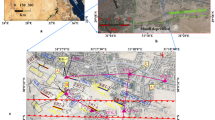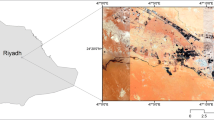Abstract
Integrated geophysical surveys using ground penetrating radar (GPR), seismic and electrical resistivity tomography, are carried out to characterize the subsidence, combining with engineering examples in the Glauber's salt mining area in the northwestern region of Gansu Province, China. Because some of the dissolved ore bodies in the Glauber's salt mining area are accompanied by the top and floor, the geophysical response of the floor strata has different physical properties. It is theoretically feasible to use resistivity imaging, GPR and seismic methods to detect. However, it is very necessary to choose an effective geophysical method through experimentation. the limitations of electrical resistivity tomography method and GPR are discussed: in actual work, if the electrical difference between the target body and the surrounding rock is not large enough, the conventional electrical resistivity tomography method cannot be used for fine detection; due to factors such as human noise from the mine's annex, the GPR electromagnetic wave reflection method cannot carry out effective work. Seismic refraction tomography processing is discussed and it was found that the interpretation results of refraction wave tomography can better distinguish the strata in the sub-survey area, which has an excellent effect on the delineation of the range of dissolution and collapse in Glauber's salt mine. Theory and engineering examples prove that seismic refraction wave tomography technology has good applicability in the detection of underground dissolution areas in Glauber's salt mines.










Similar content being viewed by others
References
Adedibu SA, Abimbola C (2019) Insight into seismic refraction and electrical resistivity tomography techniques in subsurface investigations. Min Geol Pet Eng Bull. https://doi.org/10.17794/rgn.2019.1.9
Cai HT, Hao KC, Jin X (2015) A three-dimensional Vp, Vs, and Vp/Vs crustal structure in Fujian, Southeast China, from active-and passive-source experiments. J Asian Earth Sci 111:517–527
Chapman CH, Leaney WS (2012) A new moment-tensor decomposition for seismic events in anisotropic media. Geophys J Int 188(1):343–370. https://doi.org/10.1111/j.1365-246X.2011.05265.x
Emmanuel H, Akwasi AA, Vandycke AS, Sylvester KD, Callistus N (2020) Mapping the subsurface structure of the suevite deposit in the north of the Bosumtwi impact crater using electrical resistivity and seismic refraction tomographies. Ann Geophys. https://doi.org/10.4401/ag-7752
Ford SR, Dreger DS, Walter WR (2009) Identifying isotropic events using a regional moment tensor inversion. J Geophys Res Solid Earth 114(B1):B01306. https://doi.org/10.1029/2008JB005743
Forte E, Pipan M (2017) Review of multi-offset GPR applications: data acquisition. Proc Anal Signal Process 132:210–220
Foulger GR, Wilson MP, Gluyas JG (2018) Global review of human-induced earthquakes. Earth Sci Rev 178:438–514
Henckens ML, Van Ierland EC, Driessen PP, Worrell E (2016) Mineral resources:geological scarcity, market price trends, and future generations. Resour Policy 49:102–111. https://doi.org/10.1016/j.resourpol.2016.04.012
Hu XY, Bi BT, Liu GX (2017) The lithospheric electrical structure of Ji′an-Fuzhou profile in the east part of South China. Chin J Geophys (in Chinese) 60(7):2756–2766. https://doi.org/10.6038/cjg20170721
Iqbal I et al (2020) Symmetry between theoretical and physical investigation of water contamination using amplitude variation with offset analysis of ground-penetrating radar data. Symmetry 12(6):991
Kuo YW, Wang CY, Kuo-Chen H (2016) Crustal structures from the Wuyi-Yunkai orogen to the Taiwan orogen: The onshore-offshore wide-angle seismic experiments of the TAIGER and ATSEE projects. Tectonophysics 692:164–180
Li GF, Qin DH, Peng GX (2013) Experimental analysis and application of sparsity constrained deconvolution. Appl Geophys 10(2):191–200
Li Z, Guo B, Liu QY (2015) Parameterization in seismic tomography. Prog Geophys (in Chinese) 30(4):1616–1624. https://doi.org/10.6038/pg20150416
Li P, Cai HT, Jin X (2019) Basement structure beneath the southeastern margin in Chinese continent. Chin J Geophys (in Chinese) 62(8):2991–3003. https://doi.org/10.6038/cjg2019M0136
Liu JP, Wang YY, Liu Z (2015) Progress and application of near-surface reflection and refraction method. Chin J Geophys (in Chinese) 58(9):3286–3305. https://doi.org/10.6038/cjg20150923
Mfoniso U, Aka OEA, Johnson CI, Mboutidem DD (2020) Assessing the susceptibility of structural collapse using seismic refraction method. Earth Sci Malays 4(2):109–114. https://doi.org/10.26480/esmy.02.2020.129.134
Minson SE, Dreger DS (2008) Stable inversions for complete moment tensors. Geophys J Int 174(2):585–592. https://doi.org/10.1111/j.1365-246X.2008.03797.x
Niklas J, Garnet W, Christopher J (2012) 3D seismic survey at the Millennium uranium deposit, Saskatchewan, Canada: Mapping depth to basement and imaging post-Athabasca structure near the orebody. Geophysics 77(5):245–258
Parsekian AD (2018) Inverse methods to improve accuracy of water content estimates from multi-offset GPR Parsekian: improved accuracy of water content from GPR. J Environ Eng Geophys 23(3):349–361
Schmelzbach C, Tronicke J, Dietrich P (2012) High-resolution water content estimation from surface-based ground-penetrating radar reflection data by impedance inversion. Water Resour Res 48(8):64–69
Shuler A, Nettles M, Ekström G (2013) Global observation of vertical-CLVD earthquakes at active volcanoes. J Geophys Res Solid Earth 118(1):138–164. https://doi.org/10.1029/2012jb009721
Trutnevyte E, Wiemer S (2017) Tailor-made risk governance for induced seismicity of geothermal energy projects:an application to Switzerland. Geothermics 65:295–312
Waldhauser F, Ellsworth WL (2000) A double-difference earthquake location algorithm: Method and application to the northern Hayward fault, California. Bull Seismol Soc Am 90(6):1353–1368
Walter F, Clinton JF, Deichmann N (2009) Moment tensor inversions of icequakes on Gornergletscher, Switzerland. Bull Seismol Soc Am 99(2A):852–870. https://doi.org/10.1785/0120080110
Wang K (2008) Main geologic environmental problems and control in the Meishan Glauber deposit. Sichuan Acta Geologica Sichuan (in Chinese) 28(3):225–229
Wang L, Li ZW, Wang XB (2008) A study of Gedogical Radar to cavern detection and physical analogue. Prog Geophys (in Chinese) 23(1):280–283
Wang XW, Qin GS, Zhao WF (2012) Application of forward modeling technology in seismic acquisition design. Prog Geophys (in Chinese). 27(2):642–650. https://doi.org/10.6038/j.issn.1004-2903.2012.02.029
Wang C, Zha E, Tian YT (2013) Experiment of low-frequency GPR new technique in landslide investigation. Prog Geophys (in Chinese) 28(2):1057–1063. https://doi.org/10.6038/pg20130260
Wang M, Zhang JZ, Deng Y (2017) Identification of marine gas-hydrate reservoir using seismic reflection traveltime tomography. Prog Geophys (in Chinese) 32(1):401–407. https://doi.org/10.6038/pg20170157
Wiemer S, Kraft T, Trutnevyte E (2017) Good Practice”guide for managing induced seismicity in deep geothermal energy projects in Switzerland. Zürich: Swiss Seismological Service
Xiao LF (2012) Application of comprehensive geophysical exploration method to karst exploration after construction. Chin J Eng Geophys (in Chinese) 9(2):160–164. https://doi.org/10.3969/j.issn.1672-7940.2012.02.007
Xu XQ, Su LJ, Liang SQ (2015) A review of geophysical detection methods of landslide structure characteristics. Prog Geophys (in Chinese) 30(3):1449–1458. https://doi.org/10.6038/pg20150361
Yadav A, Bansal BK, Pandey AP (2016) Five decades of triggered earthquakes in Koyna-Warna Region, Western India—a review. Earth Sci Rev 162:433–450
Yang J, Wu W (2003) The application of geophysical prospecting techniques to geological hazard exploration. Geophys Geochem Explor (in Chinese) 27(5):333–337
Yang TC, Feng JX, Wang ZJ (2011) The application of GPR to the exploration of karst caves in the foundation of bridge tower and its signal analysis. Geophys Geochem Explor (in Chinese) 35(2):280–284
Yang JM, Wei ZZ, Gao X, W. (2014) The application of the methods of high density resistivity method and transient electromagnetic to detecting coal mining goaf and to inspect grouting effect. Prog Geophys (in Chinese) 29(1):362–369. https://doi.org/10.6038/pg20140151
Zhang P, Liu H, Li YM (2000) The situation and progress of ray tracing metod resaerch. Prog Geophys (in Chinese) 15(1):36–45. https://doi.org/10.3969/j.issn.1004-2903.2000.01.002
Zhang FX, Yu DX, Zhang GC (2014) A simple numerical example for seismic traveltime tomography. Prog Geophys (in Chinese) 29(3):1080–1083. https://doi.org/10.6038/pg20140310
Zhou B, Stewart G (2008) Non-linear traveltime inversion for 3-D Seismic tomography in strongly anisotropic media. Geophys J Int 172(1):383–394
Acknowledgements
This research is supported by the National Natural Science Foundation of China (No. 42062015) and the Natural Science Foundation of Guangxi (No. 2018AD19204). We gratefully acknowledge the Editors and Reviewers for providing thoughtful and useful suggestions.
Author information
Authors and Affiliations
Corresponding author
Additional information
Publisher's Note
Springer Nature remains neutral with regard to jurisdictional claims in published maps and institutional affiliations.
Rights and permissions
About this article
Cite this article
Jianliang, W., Iqbal, I., Sanxi, P. et al. Integrated Geophysical Survey in Defining Subsidence Features of Glauber's Salt Mine, Gansu Province in China. Geotech Geol Eng 40, 325–334 (2022). https://doi.org/10.1007/s10706-021-01877-x
Received:
Accepted:
Published:
Issue Date:
DOI: https://doi.org/10.1007/s10706-021-01877-x




